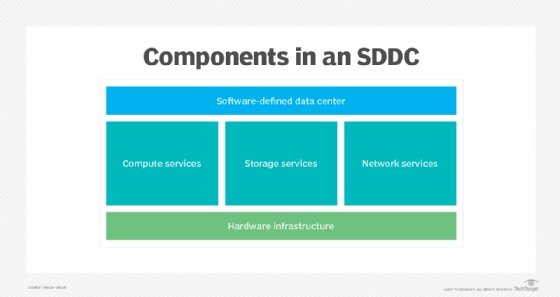
carloscastilla - Fotolia
Software-defined data center architecture basics for beginners
The physical, virtualization and management layers of an SDDC make it possible to pool the physical components into logical resources, regardless of the underlying hardware.
The software-defined data center is an approach to data management that uses virtualization to abstract compute, storage and network resources and delivers them as services. To facilitate this process, the SDDC includes intelligent software to centrally manage the virtualized resources and to automate operations and workload distribution.
Software-defined data center architecture can be broken into three logical layers: physical, virtualization and management. Together, these layers provide a unified system that offers a more flexible and cost-effective approach to data center management than organizations can achieve with traditional technologies.
The physical layer
The physical layer of the software-defined data center architecture includes the compute, storage and network components the SDDC needs to store and process enterprise data. The components can be made up of commodity hardware and originate from different vendors, which helps companies decrease costs and avoid vendor lock-in. But this flexibility can also make implementing an SDDC more complex.

The compute components normally include multiple server nodes combined in a cluster architecture. The nodes provide the processing and resources to support data operations. Because the clusters can be made up of commodity hardware, it's easier and cheaper for IT to replace a node that fails than with premium systems.
The storage components can be made up of a variety of technologies, such as a SAN, NAS or DAS. The equipment can also include HDDs and SSDs. In addition, organizations can utilize their existing storage systems, which helps them avoid more expenditures than are necessary.
The network components of the SDDC architecture include the physical hardware to facilitate communication across the compute and storage resources and protect corporate data. The hardware can include switches, routers, gateways and any other components necessary to support the clustered architecture and SDDC communications.
The virtualization layer
Virtualization is a key part of the software-defined data center architecture. The virtualization layer contains the software to abstract the underlying resources and make them available as integrated services. At the heart of the virtualization layer is the hypervisor, which delivers the resources as virtualized components.
Compute virtualization is based on tried-and-true server virtualization practices that decouple the processing and resources from the physical server. It makes those resources available as pools of logical compute components and increases resource sharing and utilization. Applications have no knowledge of the underlying physical servers and rely exclusively on the virtualized processing and resources.
Storage virtualization has not been around as long as server virtualization but is similar in concept. Storage virtualization abstracts the underlying physical devices and presents the available storage as a logical resource pool. Applications are indifferent to the type, number and size of the storage devices. Similar to software-defined storage, storage virtualization abstracts the specifics of the underlying hardware. This makes it possible to provide each application with the storage it needs, without affecting other applications.
Network virtualization is a relatively virtualization technology, but like server virtualization, it decouples available resources from the underlying hardware. It separates the physical bandwidth into independent channels that IT administrators can assign or reassign to specific workloads in real time. To make this possible, the virtualized network provides a flexible pool of logical network services for on-demand allocation. This results in more flexible and rapid configuration and provisioning.
The management layer
Virtualizing the physical resources is only part of the software-defined data center architecture. The infrastructure also includes a management layer for orchestrating and automating operations. The management layer ties together the virtualized resources into a unified SDDC that can allocate those resources to specific workloads and then reallocate those resources as requirements change.
Intelligent software provides a framework to centrally administer and monitor the SDDC infrastructure and its workloads. It can manage virtual resource placement, automatically optimize resource allocations and perform a number of other tasks. Administrators have a single interface to access and control the virtualization layer and its supporting components.
The management layer includes monitoring, alerting and scheduling capabilities so admins can oversee operations, maintain performance and carry out advanced analytics. In addition, the layer is integrated with the security and data protection mechanisms built into the software-defined data center architecture.
The management layer also provides the business logic to translate application requirements and requests into API instructions that carry out the orchestration and automation operations. The APIs make it possible for the management and virtualization software to provision and manage resources, as well as address policy implementation and service-level agreements.








